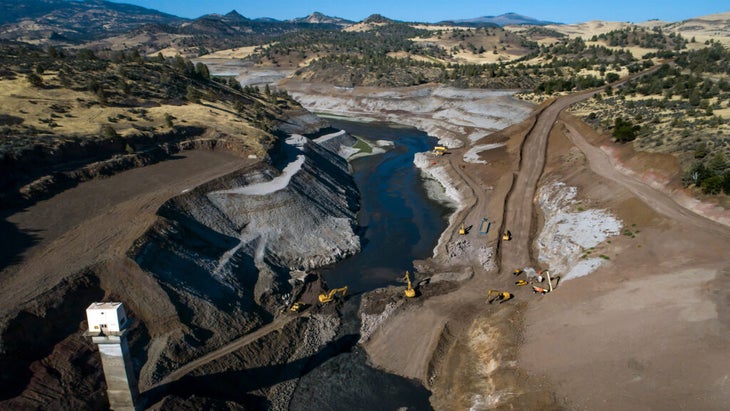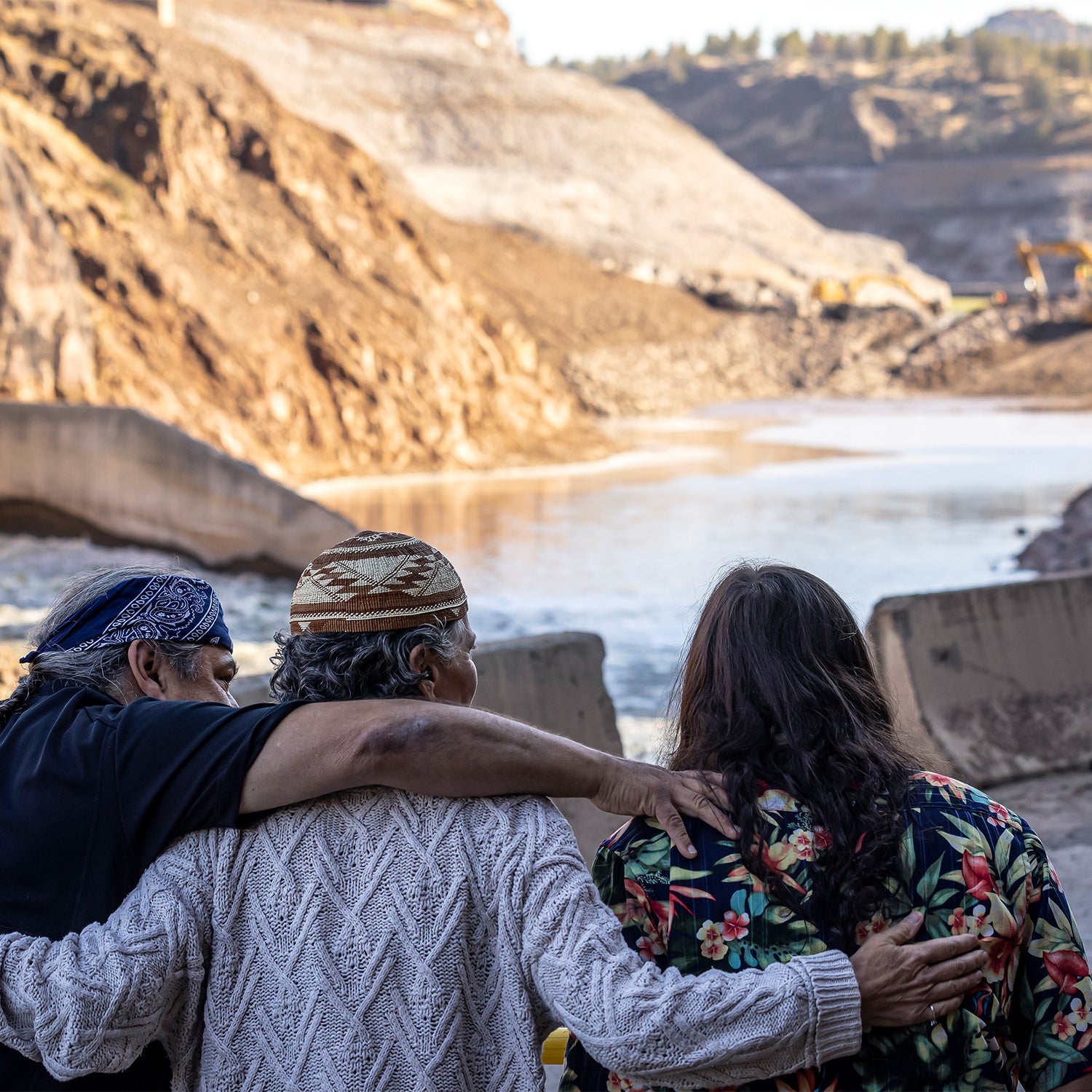The first time river guide Bart Baldwin ever dipped a paddle into whitewater, he was rafting Oregon’s Upper Klamath River. “It spoiled me,” recalls Baldwin, who grew up near the river. That initial experience sparked a passion for paddling that Baldwin parlayed into a career that led him across the country—and back to the Upper Klamath, where he’s operated Noah’s Rafting Company since 2008. He discovered that the “UK” whitewater had few equals. “It was unique,” Baldwin says. “It wasn’t natural by any means, but unique.”
Timed releases out of JC Boyle dam created surges in the river’s flow and some of the biggest (class III and IV) rapids in the Pacific Northwest. And the water was a comfortable temperature: Unlike the bracing snowmelt that many rafters brave across the western United States, the Upper Klamath water that flowed from Boyle Reservoir and Upper Klamath Lake farther upstream was known for its warmth. The crowd-pleasing day trip accounted for more than 50 percent of Baldwin’s annual revenue.
But summer 2023 was the last season for the dam-dictated Upper Klamath. JC Boyle and three other Klamath River dams were dismantled between July 2023 to October 2024, and without those timed, high-volume releases, the Klamath no longer offers its famously thrilling whitewater. The river, which had been dammed for over 100 years, has yet to settle into its new normal—and it’s unclear whether it will have sufficient flows to be navigable at all.
Saying goodbye to that income, and to the rapids that inspired Baldwin to devote his life to running rivers, came hard. The Upper Klamath, which runs through high-desert western juniper forests that grow in volcanic soils, “feels like home,” Baldwin says. “I spent 30 years up there, and they were some of the best years of my life.”
The removal of JC Boyle and the other three dams is the world’s largest-ever dam removal project, affecting a 41-mile stretch of the Klamath River flowing between Oregon and California. Built between 1908 and 1962 to generate electricity for nearby communities, these four hydroelectric dams submerged indigenous lands, blocked salmon passage, and created pockets of warm water where toxic blue-green algae thrived. Deconstructing them promises to repair significant social and environmental damage, and consequently, many people celebrated when the smallest of the four dams, called Copco Number Two, was removed in summer 2023. Drawdown of the other three reservoirs continued in January 2024, and the project was officially completed in October. Keno Dam, which sits far upriver, was left in place because it has a fish ladder and provides irrigation for farmland.
This change promises, in the long-term, to improve water quality and allow salmon to reach their former upstream spawning grounds. But there are unwelcome tradeoffs: People who lived and worked along the dammed Klamath had built homes and businesses that relied on its series of reservoirs and rapids, and many of these stakeholders had opposed the dams’ removal. Since the dams have come down, property values along the former lakes have declined. The region’s sprawling farms and ranching families also fought the project because the dams routed water to their lands. And some environmentalists question whether salmon can or will return to upriver spawning grounds. Rafting outfitters anticipate significant financial losses now that dam releases no longer produce the rapids that attracted boaters. People stand to lose not just money, but also their identities.
Envisioning a New and Undiscovered River
Historical and scientific records yield only a few clues about what the Klamath River was like before it was dammed. The annals confirm little beyond the fact that fall- and spring-run chinook salmon, Pacific lamprey, and steelhead trout all used to migrate to some unconfirmed point near the headwaters of the Klamath River, at marsh-ringed Upper Klamath Lake.
The Klamath that living people have come to know starts there, at a shallow basin that hugs the eastern edge of Oregon’s Cascade Range for 25 miles. Those warm waters flow through Keno Dam, JC Boyle Reservoir and Dam, and into Copco Lake” before spilling out through Copco One and Copco Two and passing myriad agricultural diversions along the course to Iron Gate Dam. From there, the Klamath picks up speed as it slices through northern California for 200 miles to meet the Pacific Ocean near Crescent City.
Baldwin, a lifelong adventurer, can’t help but feel curious about the potential for continued exploration on the newly free-flowing river. “There is some opportunity here,” he says of the transformed stretches of riverbed. “We’ll push off in boats and wonder what’s around the corner. We’ll run something with no beta, and that’s so unheard-of in the Lower 48,” Baldwin says.
Already, he’s scouted , a stunning 1.7-mile chasm of columnar basalt that had been dried up by Copco Two dam. Future flows there may range from 5,000 to 10,00 cubic feet per second (CFS) in winter to 700 to 1,000 CFS in summer for class III and IV rapids. “That was pretty cool to see,” says Baldwin.
Because the flows on the future Klamath River will be lower than the summertime surges facilitated by the dams, big rafts probably won’t be able to negotiate the new runs. Baldwin is mulling the possibility of offering multi-day fishing trips in small catarafts that can plumb technical water through remote canyons.
“I don’t know if salmon are going to be teeming through that section. I hope they do,” says Baldwin, noting that large-scale, water-hungry agricultural operations have appeared along the Klamath River and challenge the return of historic flows. “I hope that with the dams out, that entire river system will heal, and be better in the long run.”
That vision tests Baldwin’s faith. Nevertheless, he’s putting plans in place—in part because he enjoys seeking solutions to novel problems that haven’t already been solved. The future is uncertain, but it could be exciting. “I could be a taxi into some of the newest and most unique fly-fishing spots in the US,” says Baldwin.

Connecting Past and Future Visions
Since 1918, salmon and steelhead have bumped their heads against the aptly-named Iron Gate dam, the lowest of the four dams and an impassable barrier for migrating fish, which was removed on May 5 of this year. Installing fish ladders and updating the aging hydroelectric infrastructure at Iron Gate and other Klamath River dams wasn’t worth the expense, decided PacifiCorps, the energy company that operated the dams. And so, after decades of protests from the region’s indigenous tribes, California and Oregon issued approval for dam removal to restore habitat for four keystone fish species: Chinook salmon, Coho salmon, Pacific lamprey, and steelhead trout.
“Conifer forests benefit from the marine-derived nutrients,” explains Keith Parker, senior fisheries biologist for the Yurok Tribe, one of several entities that’s working to restore the Upper Klamath and its sea-run species. Salmon, steelhead, and Pacific lamprey spend most of their lives in the ocean, which fattens them for their long migration (totaling hundreds of miles) up the Klamath River to reproduce. Their eggs feed other fish, such as bull trout, and their carcasses enrich the soil to nourish some of the world’s tallest, oldest trees. Multiple, cascading ecological processes rely on these fish.
The fish have both biological and cultural significance, explains Parker. “They have fed our people since time immemorial with high-quality protein,” he continues. The Yurok people now eat a primarily commercial diet, but Parker is hopeful that the return of the salmon could help them reconnect with ancestral foods and traditions. His tribe suffers disproportionately from obesity, diabetes (at twice the national average), and poor mental health. are 14 times higher than the national average. Parker believes that sourcing local, nutritious food is an important step towards better community health.
Parker considers the fish population and the Yurok people intertwined. “My people were wiped out to fewer than 1,000 of us, and the salmon experienced their own genocide,” says Parker. The Klamath River’s current salmonid population represents just two percent of historic levels. “Yet they still persist,” continues Parker. When he imagines the future of the Klamath River, he looks to the distant past.
“Salmon are in the fossil record,” Parker says. The oldest salmon fossils in Oregon are . That history gives him confidence that they will return, which many people outside the tribal community view as uncertain. To Parker, a hundred-year lapse can’t permanently interrupt a five-million-year-old habit.
Parker also draws inspiration from more recent proof of salmonids’ resiliency. “There have been close to 250 dam removals in the western US, and the common thread among all of them is that within a short period of time—literally months—biologists found juvenile salmon and larval-stage lamprey above the dam sites,” he said. As of this writing, As of this writing, Chinook salmon have started to into the previously inaccessible water above the Iron Gate dam site, roughly 150 miles from the California coast. They haven’t yet reached the former JC Boyle reservoir, 32 miles farther upriver in Oregon.
Focusing on the Future
After Danny Fontaine moved to the shores of Copco Lake in 2011, he’d spend the mornings and evenings on his dock, casting a fishing rod for perch, bass, and crappie. The water shimmered just below his lakeside home, with a 150-step staircase linking his back door to the shore. Some days, he captained a pontoon boat across the water; other times he launched his motor boat. Now, the lake has receded back to a river.
His home sits among a small cluster of buildings: There’s the defunct Copco Lake Store (which Fontaine owns and hopes to remodel), the fire station, the Community Center, and its outdoor swimming pool. These buildings and the residents they serve : nobody knows for sure how the river—or the local economy—will regenerate. Amid that climate of precarity, Fontaine’s work as a real estate agent has dried up.
But Fontaine is training his eye on the future. He seeks solace in tangibles such as the Copco Lake Store and the interior remodeling that it requires. “Thinking about that makes me feel good,” he says. His hope is that rafting outfitters might find a way to continue to offer float trips on the new river, and that those boaters would use the future store as a resupply station. Maybe creating a new campground would give visitors a reason to come to the community that once occupied the southeast end of Copco Lake.
Such visions of the future help Fontaine accept this change. He also reminds himself that the Copco residents will persist, even without the lake. Throughout the year, the Community Center hosts monthly dinners involving area residents. Fontaine or his husband Francis Gill, a trained chef and the Community Center’s president, typically cooks for the group. “Everyone out here is fairly tight-knit,” says Fontaine.
“Nobody here has sold their house because of the dam removal, nor do they plan to,” he says, concluding, “We won’t be able to have the water, but we’ll be able to have the community.”


